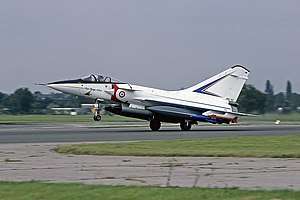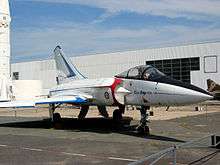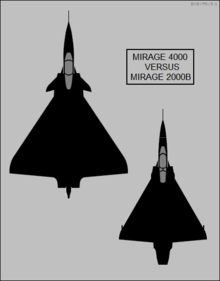Dassault Mirage 4000
The Dassault Mirage 4000 (sometimes named the Super Mirage 4000) was a French prototype twinjet fighter aircraft developed by Dassault-Breguet from their Mirage 2000.
| Mirage 4000 | |
|---|---|
 | |
| Mirage 4000 prototype | |
| Role | Prototype fighter aircraft |
| National origin | France |
| Manufacturer | Dassault-Breguet |
| First flight | 9 March 1979 |
| Status | Program cancelled in the 1980s |
| Primary user | French Air Force |
| Number built | 1 |
| Developed from | Dassault Mirage 2000 |

Design and development
The Mirage 4000 was noticeably larger and heavier than the single-engined Mirage 2000, the 4000 having two SNECMA M53-2 turbofans.[1] It also featured small canards above the engine air intakes and a true bubble canopy, compared to the Mirage 2000 and previous Mirages. Despite the changes, the two aircraft remained similar, sharing the delta wing design, semi-circular air intakes, and general configuration.
The Mirage 4000 first flew on 9 March 1979.[1] It was financed as a private venture by Dassault.[1] The Mirage 4000 was comparable in size to the United States F-15 Eagle, and was designed to be both a long-range interceptor and a capable fighter-bomber.
In the early 1980s, Dassault ended the program shortly after the Saudis chose the Tornado (see Al-Yamamah arms deal) as their preferred aircraft. Also Iran was lost as potential customer after the coup against the Shah.[2] The French Air Force preferred to concentrate on the Mirage 2000, leaving Dassault with no customers. Some of the expertise thus gained would later influence the Dassault Rafale.[3] The only prototype moved to its final residence at the Musée de l'Air et de l'Espace (Paris Air and Space Museum) in 1995.
Specifications (Mirage 4000)

Data from Jane's all the World's Aircraft 1984–85,[4] Dassault Aviation[5]
General characteristics
- Crew: 1
- Length: 18.7 m (61 ft 4 in)
- Wingspan: 12 m (39 ft 4 in)
- Height: 5.8 m (19 ft 0 in)
- Wing area: 73 m2 (790 sq ft)
- Gross weight: 16,100 kg (35,494 lb) combat weight
- Fuel capacity: approx 11,000 l (2,900 US gal; 2,400 imp gal) internal fuel
- Powerplant: 2 × SNECMA M53-2 afterburning turbofan engines, 64.3 kN (14,500 lbf) thrust each dry, 95.1 kN (21,400 lbf) with afterburner
Performance
- Maximum speed: 2,445 km/h (1,519 mph, 1,320 kn) max level speed
- Maximum speed: Mach 2.3
- Maximum sustained speed: M2.2
- Approach speed: 260 km/h (160 mph; 140 kn)
- Range: 2,000 km (1,200 mi, 1,100 nmi)
- Combat range: 1,850 km (1,150 mi, 1,000 nmi) plus, with external tanks and recce pod
- Service ceiling: 20,000 m (66,000 ft)
- Rate of climb: 305 m/s (60,000 ft/min)
- Time to altitude: 15,000 m (49,213 ft) (M2) 3 minutes
- Wing loading: 220 kg/m2 (45 lb/sq ft) at combat weight
Armament
- Guns:
- 2x 30 mm (1.181 in) DEFA cannon with 125 rpg
- Hardpoints: 11 with a capacity of 8,000 kg (17,637 lb) +,with provisions to carry combinations of:
- Other:
- Other:
- up to 3x 2,500 l (660 US gal; 550 imp gal) drop tanks
- FLIR pod
- Recce pod
- laser designator pod
- Rockets:
- up to 4x rocket pods
- Missiles:
- 2x long-range AAM
- 8-14 advanced AAMs
- up to 4 AGMs
- Bombs:
- up to 27 x 250 kg (551 lb) bombs
See also
Related development
Aircraft of comparable role, configuration and era
Related lists
References
| Wikimedia Commons has media related to Dassault Mirage 4000. |
- Jackson, Paul A. (1985). Mirage : Modern combat Aircraft 23 (1st ed.). Shepperton: I. Allan. pp. 116–117. ISBN 9780711015128.
- Mirage 4000 Origins and prototypes
- "Mirage 4000".
- Taylor, John W.R., ed. (1984). Jane's all the World's Aircraft 1984–85 (75th ed.). London: Jane's Publishing Co. p. 65. ISBN 0-7106-0801-2.
- "Mirage 4000" (in French). Dassault Aviation. Archived from the original on 2009-02-03. Retrieved 2009-01-24.